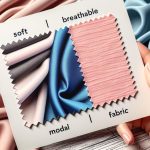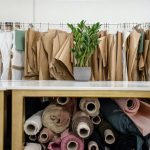Are you curious about the latest sustainable fabric trends in the fashion industry? Look no further!
In this article, we’ll explore the top choices for eco-friendly materials, from organic cotton to recycled polyester.
Discover the benefits of hemp and linen blends, as well as innovative fibers like Tencel and Modal.
You’ll even learn about plant-based leathers like Piñatex and the beauty of upcycled and repurposed fabrics.
Get ready to embrace fashion that’s both stylish and sustainable.
Table of Contents
Organic Cotton
When choosing sustainable fabrics for your fashion items, consider using organic cotton, which is grown without the use of synthetic pesticides or fertilizers. Organic farming has several benefits, both for the environment and for the health of the farmers. By avoiding the use of synthetic chemicals, organic farming promotes soil fertility and biodiversity, reducing the risk of soil erosion and water pollution. Additionally, organic farming practices often involve crop rotation and the use of natural fertilizers, which can improve soil quality and reduce the need for irrigation.
The market demand for organic cotton has been steadily increasing in recent years, as more consumers become aware of the environmental and health impacts of conventional cotton production. Organic cotton is considered a sustainable alternative to conventional cotton, as it requires less water and energy to grow. Furthermore, organic cotton farmers receive fair prices for their crops, helping to support rural communities and promote social sustainability.
Recycled Polyester
Recycled polyester is a game-changer in the fashion industry. It offers durability and longevity, making it a sustainable alternative to traditional polyester.
By reducing environmental impact through recycling, it also aligns with the growing demand for eco-friendly fashion.
Its versatility in fashion design allows for endless possibilities in creating stylish and sustainable clothing.
Durability and Longevity
You can easily spot the growing trend of using recycled polyester fabric for its durability and longevity in the fashion industry. With improved manufacturing techniques and the rise of eco-conscious consumer habits, more and more fashion brands are incorporating recycled polyester into their collections. This sustainable fabric is made from post-consumer plastic bottles and other discarded polyester products, reducing waste and environmental impact. Not only is recycled polyester a great choice for the planet, but it also boasts excellent durability and longevity. It is resistant to stretching, shrinking, and wrinkling, making it a practical option for clothing that needs to withstand daily wear and multiple washes. Take a look at the table below to see the benefits of using recycled polyester fabric:
| Benefits of Recycled Polyester Fabric |
|---|
| Durability |
| Longevity |
| Eco-friendly |
Environmental Impact Reduction
To reduce the environmental impact in the fashion industry, consider incorporating garments made from recycled polyester fabric. Recycled polyester is created by upcycling initiatives that transform plastic waste, such as bottles, into usable fabric.
This not only reduces the amount of plastic waste that ends up in landfills or oceans but also decreases the demand for virgin polyester production, which is resource-intensive.
Additionally, sustainable dyeing techniques can be used to minimize the environmental impact of the dyeing process. These techniques often involve using natural dyes or low-impact dyes that require less water and energy, and produce less waste.
Versatility in Fashion Design
When incorporating garments made from recycled polyester fabric, it’s important to consider the versatility it offers in fashion design. Here are some key points to understand about the role of recycled polyester in creating innovative designs and sustainable materials:
- Recycled polyester can be blended with other fabrics to create unique textures and finishes.
- It can be dyed in a wide range of colors, allowing for endless design possibilities.
- The fabric is durable and resistant to wrinkles, making it perfect for everyday wear.
- Recycled polyester can be transformed into various garment styles, from casual t-shirts to elegant dresses.
- It offers designers the opportunity to experiment with different techniques, such as pleating, draping, and embellishments.
Hemp and Linen Blends
Looking for an eco-friendly fabric option that offers versatility in fashion? Consider hemp and linen blends.
These blends have been gaining popularity in sustainability due to their durability, breathability, and natural fibers.
Whether you’re looking for a stylish outfit or a comfortable everyday wear, hemp and linen blends provide a sustainable solution without compromising on style.
Eco-Friendly Fabric Option
You can choose eco-friendly fabric options such as hemp and linen blends. These fabrics are made from natural fibers and are produced using sustainable manufacturing methods.
Here are five reasons why hemp and linen blends are a great choice for environmentally conscious fashion:
-
Sustainable cultivation: Hemp and linen are grown using minimal water, pesticides, and fertilizers, reducing their impact on the environment.
-
Biodegradable: Once discarded, hemp and linen fabrics naturally decompose, unlike synthetic materials that contribute to landfill waste.
-
Durability: Hemp and linen blends are known for their strength and durability, allowing garments made from these fabrics to last longer.
-
Breathability: The natural fibers in hemp and linen blends allow air to circulate, keeping you cool and comfortable in hot weather.
-
Versatility: Hemp and linen blends can be used to create a wide range of clothing and accessories, from casual wear to formal attire.
Versatility in Fashion
If you’re considering sustainable fabric options, hemp and linen blends offer versatility in fashion. These blends are at the forefront of fashion innovation, providing designers with the opportunity to create unique and eco-friendly pieces.
Hemp and linen are both natural fibers that are known for their durability and breathability. When combined, they offer a fabric that isn’t only sustainable but also incredibly versatile.
Hemp and linen blends can be used to create a wide range of fashion pieces, from lightweight summer dresses to tailored suits. Whether you’re looking for casual or formal wear, these blends can be tailored to suit any style.
Growing Popularity in Sustainability
The growing popularity of sustainability in the fashion industry is evident in the increasing demand for hemp and linen blends, which offer designers like you the opportunity to create unique and eco-friendly pieces. These blends not only provide a sustainable alternative to traditional fabrics but also boast several other benefits:
-
Versatility: Hemp and linen blends can be used to create a wide range of garments, from casual wear to high-end fashion.
-
Durability: These blends are known for their strength and resistance to wear and tear, ensuring that your designs stand the test of time.
-
Breathability: Hemp and linen blends allow for better airflow, making them ideal for summer clothing.
-
Sustainability: By using hemp and linen blends, you contribute to ethical manufacturing practices and support the growth of the circular fashion movement.
-
Eco-friendliness: Hemp and linen are natural fibers that require less water and fewer pesticides to grow, making them more environmentally friendly choices.
Tencel and Modal Fibers
Tencel and Modal fibers are sustainable fabric options that offer durability and softness. These fibers are often blended together, resulting in a fabric that combines the best features of both materials.
Tencel, also known as lyocell, is made from cellulose derived from sustainably harvested trees. It’s produced using a closed-loop system, which means that the solvents used in the process are recycled and reused, making it an environmentally friendly choice. Modal, on the other hand, is made from beech trees and also utilizes a closed-loop production process.
Both Tencel and Modal fibers have gained popularity in recent years due to their sustainability in textile production.
One of the key benefits of Tencel and Modal blends is their eco-friendliness. The production of these fibers requires less water and energy compared to conventional cotton or synthetic fabrics. Additionally, the closed-loop production process ensures that no harmful chemicals are released into the environment. These fibers are also biodegradable, meaning that they can easily break down without causing harm to the environment.
In addition to their sustainability, Tencel and Modal blends offer exceptional softness and comfort. The fibers have a smooth and silky texture, making them ideal for creating luxurious and comfortable garments. They’re also highly breathable, allowing for better moisture absorption and temperature regulation. Furthermore, Tencel and Modal fabrics have excellent draping properties, resulting in garments that hang beautifully on the body.
Piñatex and Other Plant-Based Leathers
When considering sustainable fabric options in the fashion industry, you can explore the benefits of Piñatex and other plant-based leathers. These materials offer a range of advantages that make them a popular choice among environmentally conscious consumers.
Here are some reasons why you should consider piñatex alternatives and the benefits of plant-based leathers:
-
Sustainability: Plant-based leathers, such as Piñatex, are made from renewable resources, reducing the reliance on fossil fuels and minimizing the environmental impact.
-
Biodegradability: Unlike traditional leather, plant-based leathers are biodegradable, meaning they can naturally break down over time, reducing waste and pollution.
-
Cruelty-free: Plant-based leathers are a compassionate alternative to animal skin, as they don’t involve the use of animals in their production.
-
Versatility: Piñatex and other plant-based leathers can be used to create a variety of products, from shoes and bags to furniture and interior design items.
-
Innovation: The development of plant-based leathers encourages research and innovation in sustainable materials, driving the fashion industry towards a more eco-friendly future.
Upcycled and Repurposed Fabrics
Consider repurposed garments as a sustainable option for your fashion choices. Repurposed denim and upcycled silk are two examples of fabrics that are gaining popularity in the fashion industry.
Repurposed denim refers to jeans or other denim clothing items that have been transformed into new pieces. This can involve cutting, sewing, and adding embellishments to create unique and one-of-a-kind garments. By repurposing denim, you not only give new life to old clothing but also reduce the demand for new denim production, which has a significant environmental impact.
Upcycled silk, on the other hand, involves taking discarded silk fabric or garments and transforming them into new products. This process can include dyeing, printing, or altering the fabric in various ways. Upcycling silk not only prevents waste but also reduces the need for new silk production, which often involves harmful chemicals and water-intensive processes.
Choosing repurposed denim and upcycled silk garments not only allows you to make a sustainable fashion statement but also supports the circular economy by reducing waste and conserving resources. These fabrics offer a unique and eco-friendly alternative to traditional textiles, making them a great choice for conscious consumers who want to make a positive impact on the environment.
Sustainable Synthetic Alternatives
If you’re looking for sustainable alternatives to traditional fabrics, exploring sustainable synthetic options is a great way to make eco-friendly fashion choices. Synthetic fibers have long been criticized for their negative environmental impact, but recent advancements in technology have led to the development of biodegradable fibers and sustainable textile innovations.
Here are five options to consider:
-
Bio-based polyester: Made from renewable resources such as corn and sugarcane, bio-based polyester offers a more sustainable alternative to traditional polyester.
-
Recycled nylon: By repurposing discarded fishing nets and other waste materials, recycled nylon reduces the demand for new resources and helps reduce plastic pollution.
-
Piñatex: Derived from pineapple leaves, Piñatex is a vegan leather alternative that offers a sustainable and cruelty-free option for fashion items like bags and shoes.
-
Econyl: Econyl is a regenerated nylon made from discarded fishing nets, fabric scraps, and industrial plastic waste. It can be recycled infinitely without losing its quality.
-
Tencel: Tencel is a sustainable fabric made from wood pulp sourced from responsibly managed forests. It has a low environmental impact and is biodegradable.
These biodegradable fibers and sustainable textile innovations offer a more sustainable option for fashion enthusiasts who want to make a positive impact on the environment. By choosing these alternatives, you can contribute to the reduction of waste and the conservation of resources in the fashion industry.
Frequently Asked Questions
Are Sustainable Fabrics More Expensive Than Traditional Fabrics?
Sustainable fabrics may be more expensive than traditional ones, but considering the cost comparison and environmental impact, they are worth investing in. Their long-lasting quality and positive effects on the planet are undeniable.
How Can I Determine if a Fabric Is Truly Sustainable?
To determine if a fabric is truly sustainable, start by evaluating its production processes. Look for eco labeling to verify sustainability claims. Keep in mind that measuring sustainability goes beyond just the fabric itself.
Are There Any Drawbacks to Using Sustainable Fabrics?
There are some drawbacks to using sustainable fabrics. They may not be as durable as traditional fabrics, and this can impact the fashion industry. However, the benefits of sustainability outweigh these drawbacks in the long run.
Are Sustainable Fabrics Available in a Wide Range of Colors and Patterns?
Yes, sustainable fabrics are available in a wide range of colors and patterns. Eco-friendly dyeing techniques allow for vibrant hues, while innovative fabric blends create unique designs that are both stylish and environmentally friendly.
Can Sustainable Fabrics Be Used for All Types of Clothing and Accessories?
Yes, sustainable fabric alternatives can be used for all types of clothing and accessories. Many innovative sustainable materials have been developed to meet the demand for eco-friendly fashion choices.
- What Is Chiffon Best Used For? - April 23, 2024
- Is Chiffon Fabric Itchy? - April 23, 2024
- Are There Different Types of Chiffon Fabric? - April 23, 2024





